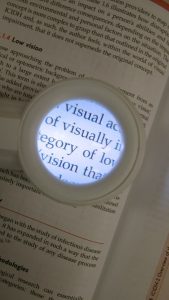La International Classification of Diseases (ICD) divides visual function into four broad categories:
–normal vision
-moderate visual impairment
-severe visual impairment
-blindness
The term 'low vision' denotes moderate and/or severe visual impairments, and these together with blindness represent all vision defects.
According to the latest estimates of the World Health Organisation (WHO), 253 million people have visual defects, Of these 36 million are blind and 217 million have moderate to severe visual impairments. The first two global causes of visual impairment are represented from uncorrected refractive errors that also include the unoperated cataract.
In recent years the percentage of visual impairment worldwide has decreased compared to early estimates in the 1990s, a reduction attributable to: general socio-economic development; concerted public health action; increased availability of eye care services; and increased awareness among the general population of the solutions that can be adopted for problems related to visual impairment. The prevalence of eye infections, such as trachoma and onchocerciasis, has also decreased significantly over the past 25 years.
Although the last few decades have seen an improvement in the overall picture of visual impairment, there is estimates that the number of people with vision defects could triple due to an increasing and ageing population. Projections suggest that by 2050 there could be 115 million blind people against 38.5 million in 2020.
However, the most recent WHO (World Health Organisation) estimates on the global extent and causes of visual impairment confirm an important opportunity for change in the lives of millions of people: 80% of all causes of visual impairment are, in fact, preventable or treatable.
The WHO project, led by Universal Eye Health, envisages a Global Action Plan 2014-2019approved by the World Health Assembly in 2013, which aims to achieve a measurable 25% reduction in avoidable visual impairment by 2019.
To this end, WHO supports Member States to make assessments and develop policies and plans to improve access to quality comprehensive eye care services. To this end, several tools have been developed for the evaluation of: eye care services; rehabilitation services and systems; diabetes and diabetic retinopathy.
The actions of Member States, international partners and the Secretariat are structured around to three main objectives:
1) produce and collect data on the extent and causes of visual impairment and eye care servicesand subsequently use this data to monitor progress, identify priorities and support eye health with increased political and financial commitment from all Member States
2) encourage the development and implementation of integrated national policies, plans and programmes to improve eye health globally; strengthen, therefore, eye care services through their integration into the health care system with activities in line with the WHO framework
3) Promoting multi-sectoral engagement and the implementation of partnerships effective in supporting eye health
The vision behind this comprehensive action plan to reduce visual impairment and ensure safe access to rehabilitation for the blind is: "a world where no one is unnecessarily visually impaired, where those with unavoidable sight loss can reach their full potential, and where there is universal access to comprehensive eye care services “
Bibliography:
- http://www.who.int/mediacentre/factsheets/fs282/en/
- Universal eye health: a global action plan 2014-2019. World Health Assembly. 2013
Dr. Carmelo Chines
Direttore responsabile

